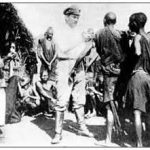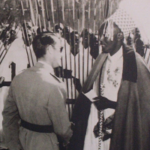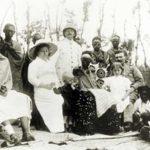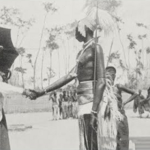Clientship During The Reign Of RWABUGIRI
In pre-RWABUGIRI Kinyaga economic and political security could usually be obtained by means other than clientship. Alternatives included ownership of land, protected by membership in a kin group exercising jurisdiction over the land, and personal ownership of cattle, obtained by marriage transfer payment, gift of friends, or purchase.
Friendship exchanges of cattle between persons of relatively equal status were also common. The local kin group could normally deal with threats to security of ownership, although for some cattle-owning lineages, clientship to an umuhetoPatron assured additional protection of herds.
Thus, clientship in Kinyaga during most of the nineteenth century was restricted in both its geographical extent and the proportion of the population affected. Most people remained autonomous from any of the forms of clientship described above. Many Kinyagans maintain that their ancestors arrived in Kinyaga without any clientship ties, either as patrons or clients. Some Hutu acquired land clients, others did not.
Although some cattleowners acquired clients, many others tended to their own cattle and fields without seeking clients to work for them. In fact, the more status-conscious Tuutsi from the central regions of the country were frequently astonished by the relatively simple life-styles of Tutsi in southwestern Rwanda, and their willingness to attend to their own needs without servants. Under these circumstances, the negotiating position of clients was relatively favorable. This situation was to change significantly under Rwabugiri and his successors.
We have seen that during Rwabugiri’s reign, central Rwandan administrative structures were established in Kinyaga and new chiefs were introduced from outsidethe region. Associated with these changes came alterations in clientship. Umuheto links were extended and altered, while two new forms of clientship were introduced: ubuhake clientship, and ubureetwa. These appeared in Kinyaga only with central administration; they thus came to be identified with mie by Nduga, and to symbolize loss of the autonomy formerly enjoyed by many lineages of the region.
These new developments, heralding significant alterations in the political arena, were initiated in Kinyaga by Ntiizimira, who, as we have seen, rose from relative obscurity to a position of power and fame under Rwabugiri’s patronage. It was he who extended umuheto in Kinyaga, who introduced ubureetwa, and who laid the groundwork for the extension of ubuhake. The king first appointed Ntiizimira chief of a region north of Kinyaga, including Rubengera, site of the first and most important royal capital in the west (in present-day Kibuye Prefecture). Later, Ntiizimira extended his domain southward, gaining command over the Impara social army, as umuheto chief, and of the Impara province, as ubutaka (land) chief. He thus controlled a continuons area stretching along Lake Kivu from the Koko River in the north (now the boundary between Kibuye and Gisenyi Prefectures) to the Rusizi River in the south.
Ntiizirnira has been described as “like a brother” to the king, and “so favored that he was lauded in proverbs. The origin of his special relationship with Rwabugiri is unclear. One explanation suggests that Rwabugiri was indebted to Ntiizimira for having cured him of leprosy, and that the king gave him Kinyaga as a reward. Another account views the grant as recognition of heroism in war. Most probably, however, Ntiizimira was elevated by Rwabugiri to counteract the power of established chiefs, leaders of the traditionally influential lineages of the kingdom. Owing his wealth and status to the favor of the king, Ntiizimira was initially more dependent on the royal court than were those chiefs whose prestige derived at least in part from their family connections. Rwabugiriis appointment of Ntiizimira to govem such a vast territory is understandable in the context of a policy of centralization. Attempting to limit the autonomy of traditionally powerful groups, the king recruited and rewarded persons who were closely dependent on him. Yet if such chiefs began to acquire an independent power base, they were expendable.
A native of Budaha (Kibuye Prefecture), Ntiizimira came to Kinyaga as a stranger with virtually no local ties. Accompanying him were several relatives and other followers who were members of the social army company (umutwe) Imbanzamihigo, the group Ntiizimira recruited when he received command of Rubengera district. Ntiizimira used these followers, many of whom were his relatives, to establish control in the northern part of Impara region, later known as Cyesha.
Other, non-Kinyagan representatives of Ntiizimira accompanied the chief into the region or arrived on their own. One of these, Rukeezamuheto, a native of Bukonya, represented Ntiizimira at Kagano. Muragizi, from Gisaka (on Rwanda’s eastem border) also commanded several hills for Ntiizimira. Strong backing from the central court, as well as control over substantial material resources (principally herds of cattle and political offices), permitted Ntiizimira to enlarge progressively this early core of supporters.
Ntiizimira used the umuheto institution to attract collaborators among Kinyagans and to augment prestations for the court. Particularly in central and southem Impara, he appointed representatives from wealthy Kinyagan families, instructing them to collect umuheto prestations from designated lineages. These representatives often delegated the actual collection to others, and so a hierarchy of authority emerged. It was customary for officials at each level to take out a “taste”(umusogongero), or portion of the prestations, which constituted their reward. This provided an incentive for individuaIs to seek appointment
and, once appointed, to augment the number of lineages paying prestations.
Under Ntiizimira, many cattle-owning lineages previously without any umuheto patron thus had to begin giving an animal umuheto cow. More important, Ntiizimira, through his delegates, recruited non-cattle-owning lineages into umuheto companies. Unable to give cows, these lineages (referred to as “Hutu”) contributed hoes or luxury items such as sleeping mats, ubutega fiber bracelets, ikirungu snake bones, animal pelts.
A Kinyagan will often date the introduction of umuheto clientship in the region to the time of the chief who commanded when his own lineage was incorporated into an umuheto company. For some this occurred under Ntiizimira; for others it was under Ntiizimira’s successors, Rwabirinda and Rwidegembya. Those whose lineages were incorporated into umuheto companies for the first time during this period portray such membership as an extra burden imposed on them which served to enrich the chiefs, but was of little advantage to those recruited.
It was difficult to reject the authority of an umuheto patron, but escape was sometimes possible through forging client ties with another powerful person-sometimes the direct superior of the local umuheto representative.The following account, referring to a period shortly after Ntiizimira’s demise, suggests the kind of maneuvering that occurred.
When my grandfather went to Rwidigembya -this was in the time of Rwabirinda- they had just put us in the Akamarashavu [umuheto group]. Then my father gave them a cow of the color urwirungu. They refused it, because it was a heifer; they wanted him to give a milk cow -the mother of this heifer. It was then that my grandfather fled and took refuge with Rwidegembya who was on a [military] expedition at the place called Gacucu. When he retumed from Gacucu, Rwidegembya said to Nyankiiko, ‘Don’t bother my Hutu any more, he’s a client like the rest of you, he’s one of mine as well.’ This was how we separated ourselves from the umuheto [demands]. That’s what it was like, when you didn’t go to [pay court top) Rwidigembya you became a slave of umuheto.
For this Kinyagan, the way to escape umuheto was to bypass Nyankiiko, the local representative exercising authority over the Akamarashavu group, and seek the direct patronage of Nyankiiko’s superior, Rwidegembya.
Perhaps the greatest source of fame (or infamy) for Ntiizimira in Kinyaga was his imposition of control over land. When Ntiizimira came to the region, most Kinyagans held land through the right of occupation; they or their ancestors had cleared their fields or obtained them through purchase or friendly agreement from those who had arrived earlier. By what right then, Kinyagans asked, could a chief such as Niizimira claim authority over their land?
Oral accounts from Kinyaga generally concur that prestations for land (amakoro y’ubutaka) and ubureetwa, a form of clientship involving manual labor for a hill chief, were introduced to the region during the time of Ntiizimira. Although land prestations and ubureetwa did resemble in some respects the earlier forms of land clientship to an ubukonde proprietor or agricultural work for an igikingi holder, Kinyagans see these demands as innovations, significantly different from what came before. Most accounts are less clear on how such authority over the land was acquired, but Yoboka provided insights on the process as it occurred at Muramba hill in the northem part of Impara.
Yoboka explained that members of his lineage had occupied their land at Muramba for at least two generations before Ntiizimira arrived in Kinyaga. Nzirimo, Yoboka’s fourth-generation ancestor and founder of the Abazirimo lineage, had left Butumbi in Ndorwa (northern Rwanda) seeking grazing land for his cattle. He made his way to Buremo in present-day Kibuye Prefecture, while some of his sons moved on south to Kinyaga, one of them settling at Muramba.
As noted above, the lineage was incorporated into the Abazimya social army during the reign of Rwogera; of that time, Rugagi commanded the Abazimya, so the Abazirimo became Rugagi’s umuheto clients. The lineage began sending Rugagi a cow for umuheto at regular intervals; these animals were contributed by the lineage as a corporate group (regardless of where members of the lineage lived) through the intermediary of Ryingoma, their lineage head at the time. The umuheto ties linking the Abazirimo to Rugagi and later to Rugagi’s son Nyandekwe continued to operate through to the end of Rwabugiri’s reign.
But when Ntiizimira arrived he imposed an additional form of prestations on lineage members. At Muramba, Ntiizimira prevented the Abazirimo from pasturing their cattle on the lineage land. In order to graze their cattle, they were compelled to offer Ntiizimira an “ubutaka cow” (cow for the land). Ntiizimira then “granted” the lineage an igikingi domain consisting of the land they already occupied and used.
Yoboka explained that Ntiizimira not only required a cow for ubutaka, but also demanded the cow from local residential units (regardless
of lineage ties). Thus, Abazirimo living at Muramba had to give one cow for their land; other Abazirimo living farther south at Rwahi also had to give a cow, and so on. This represented an important change from the umuheto form of prestations which had required only one cow from the lineage as a corporate group. Other lineages at Muramba, poorer and unable to give a cow for ubutaka, had to contribute food prestations and to work for Ntiizimira’s local representative for two days out of each five-day week.
According to Yoboka, Kinyagans were reluctant to recognize Ntiizimira’s authority, for he made them give prestations for the land and work for the chiefs, practices to which they were not accustomed. At Bitare, a hill several kilometers south of Muramba, Ntiizirnira met with stiff resistance. People there, preferring to retain their autonomy, resented having an outsider impose such demands on them. A certain Rutamu son of Rukiza led his lineage in open revolt. Ntiizimira sent his men to attack the recalcitrants, overcoming them and “forcing them to work” (kuganduura). Ntiizimira met with similar resistance at Muraza hill, and dealt with it in similar fashion. After these incidents, people in other areas submitted, giving Ntiizimira the prestations demanded. Thus, although overt resistance was not widespread, it is clear that prestations for the land were imposed by force, or at least the threat of force. Rebellion did resurface later, however, in events associated with Seevumba.
As provincial chief, Ntiizimira and his delegates posed as distributors of the land (a kind of legal fiction) and required of their “beneficiaries” the payment in cattle or food and services that had traditionally been the perquisites of a land patron. In Kinyaga, however, land clientship had been neither very common nor, where it occurred, very rigid. The idea that chiefs should control the land was new; so also was the insistence that regular prestations and services be delivered to these chiefs. It was also at this time that ubureetwa was introduced in Kinyaga -the gifts of beer and manual labor for chiefs which later became a hated symbol of Tuutsi rule.
Ntiizimira used coercion to implement his goals, but he relied on persuasion as well. He recruited allies among wealthy local families, incorporating one or more of their members into his elite corps, the Imbanzamihigo. Those who cooperated received substantial material benefits. Participating in military expeditions under Ntiizimira’s leadership, they might achieve fame and gain booty as war heroes. As favored supporters, they received official authorization to collect land prestations on one or more hills, or authority over a group of lineages for umuheto; sometimes a single delegate cornbined both roles. In addition to providing opportunities for the client to increase his wealth, these positions also permitted him to expand his own following. Some of the familles coopted by Ntiizimira achieved prominence in this manner for several of their members, not only for the lineage head. And some clients acquired their own elite corps of supporters, thus replicating the pattern by which their patron increased his power.
All whom Ntiizimira appointed to positions in the administrative hierarchy were regarded as his clients (abagaragu). The nature of the ties linking patron and client is not entirely clear, but there are indications that elements of both umuheto and embryonic ubuhake forms were present. One Kinyagan described Imbanzamihigo, Ntiizimira’s corps of followers, as a section of intoore the close followers of a chief recruited as youths for social and military training), pointing out that each member of the group gave a cow to Ntlizimira every year. According to this account, the linkage resembled an umuheto tie.
For some Kinyagan lineages membership in Imbanzamihigo clearly did have the character of umuheto clientship. The Abadegede lineage, for example, had been umuheto clients of Seerutabura until Ntiizimira’s arrivail in Kinyaga. When Seerutabura was deposed and Ntiizimira inherited his position as chief of the Impara social army, he became umuheto patron of the Abadegede. Since this lineage had been umuheto clients of Ntiizimira’s predecessor their umuheto patron changed with changes in command of the social army.
The situation was more complicated, however, when a Kinyagan lineage possessed previous umuheto ties to a patron who commanded not the Impara, but some other social army. Under Rwabugiri, lineages normally preserved their earlier umuheto ties, assuring protection of their cattle by the former umuheto patron. But lineage needed pasturage for its cattle, and perhaps individual members had ambitions to gain political power as land chiefs. Ntiizimira controlled the land, and it was he who appointed land chiefs. Thus, such lineages often found it advantageous to establish some kind of alliance with Ntiizimira, probably by having one or more of their members recruited into the Imbanzamihigo. In such a case, if the tic linking a lineage member to Ntiizimira is characterized as umuheto, then the lineage had two umuheto patrons, which served perhaps as one means of splitting a lineage. Altematively, it was an embryonic form of ubuhake clientship.
Ntiizimira’s Imbanzamihigo Company thus resembled an umuheto group, but it also showed similarities to ubuhake. This was reflected particularly in the role of hill chief positions sometimes associated with
membership in the Imbanzamihigo. Even for those lineages linked to Ntiizimira through umuheto ties, there were advantages in gaining hill chief positions. But in later periods these positions were invariably contingent on ubuhake links; their association with the early Imbanzamihigo company therefore can be taken to indicate the presence of certain ubuhake elements.
In fact, early umuheto links represented by Imbanzamihigo can be seen to have facilitated the later emergence of ubuhake ties. It is not clear whether a cow was always transferred from patron to client in such a relationship in the time of Ntiizimira. However, later (under Ntiizimira’s successors, Rwabirinda and Rwidegernbya) favored ubuhake clients did receive a cow, or a herd of cattle. A number of Kinyagans today believe that all members of a chief’s elite company, such as the Imbanzamihigo of Ntiizimira, had received cows directly from the patron. This view may reflect subsequent practices rather than the original character of the Chief’s elite company, but it suggests that the patron-client tie involved was an embryonic form of ubuhake. In this context, the introduction of ubuhake in Kinyaga was associated with the acquisition of control over land by political authorities, in a process parallel to the one which occurred earlier in central and southem Rwanda.
Clientship under Ntiizimira may indeed have been less institutionalized than portrayed in this post facto formal analysis. It is, however, less important to know the precise label attached to clientship under Ntiizimira than to understand the nature of the relationship involved. Evidence on this latter question is clear. The early ties between patron and client under Ntiizimira were bonds of alliance, characterized by mutual respect. Clientship was of relatively limited extent, still involving only a minority of the population. Clients enjoyed high status and a favorable bargaining position vis-à-vis their patron, Ntiizimira. These conditions favored a situation where clients derived significant benefits from the relationship, and in which the demands a patron made were lirnited.
The Abeerekande lineage, living at Nyarushiishi hill and neighboring areas in the Impara region of Kinyaga, provides a good illustration of the advantages to be gained through early clientship. They were one of the older Rwandan families in the region, enjoying wealth and status even before the arrival of Ntiizimira. The Abeerekande later extended their power through skiliful use of alliance ties to superiors, originally to the king, and later to Ntiizimira and his successors. By about 1911, when Rwagataraka entered the region, the Abeerekande had become one of the most powerful lineages in Kinyaga.
The founder of the Abeerekande lineage, Mwerekande, came from Gisaka to settle at Nyarushrishi hill in Kinyaga during the reign of Yuhi Gahindiro. He is said to have been a client of the king, charged with helping the court to annex Kinyaga. Mwerekande’s grandson, Rwanyamugabo, was head of the lineage when Ntiizimira came to Kinyaga. Entering into client ties with Ntiizimira, and preserving earlier client-ship links to the royal court, Rwanyamugabo assured his lineage a prominent position in the later politics of Kinyaga.
Even though the data on the Abeerekande are incomplete, certain patterns can be discerned. Until Rwabugiri’s reign, clientship to the royal court was the dominant form for this lineage. Both Mwerekande’s son, Kanywabahizi, and his grandson, Rwanyamugabo, received a herd of cattle from the king. But from the tirne of Rwanyamugabo the focus began to shift, and client ties to central chiefs appointed to govern the region began first te supplement, and later to replace, the links to the royal court. The descendants of Rwanyamugabo, for example, claim that he had client ties to the king and to Ntiizimira, as well as to the two chiefs who took power after Ntiizimira’s demise (Rwabirinda and Rwidegembya). During the time of Rwanyamugabo’s son, Nyankiiko (roughly the period of German rule and early Belgian rule) the family developed a dense network of ties to Rwidegembya, and later to his son Rwagataraka. Nyankiiko took over authority for his father’s ubuhake and umuheto clients after the death of Rwanyamugabo in the war against the Abapari. He and his brothers and cousins commanded a total of at least eleven hills in Kinyaga for Rwidegembya. It is interesting, however, that although not all Nyankiiko’s brothers held command of specific hills, at least six of them each received a herd of cattle from Rwidegembya, whom they recognized as their patron.
The nature of ties between the Abeerekande and another prominent Kinyagan lineage, the Abadegede, is revealing. The head of the Abadegede, Seekabaraga, was also a favored client of Rwidegembya. Like Nyankiiko, he and other members of his lineage gained status and wealth through client ties to chiefs such as Rwidegembya and, as we shall see, to Europeans. Patron-client ties between the Abeerekande and the Abadegede were relatively rare. But the families were closely allied through marriage ties. Nyankiiko’s cousins Ndaayi and Nyiringango eachmarried a sister of Seekabaraga. Nyankiiko’s brother Karama married a sister of Seekabaraga’s paternal uncle, and Karama’s son Nzogera married Seekabaraga’s only daughter. As our data on marriage ties of the Abeerekande are incomplete, these examples probably under-represent the number of marriage links between the two families.
For Ntiizimira, continued tenure in office depended upon his ability to collect prestations and produce manpower for military service and the construction and maintenance of royal capitals. To aid in implementing his policies, he recruited supporters among wealthy Kinyagan lineages. For such lineages, alliance with Ntiizimira offered the chance to broaden their political network; they could expect not only enhanced prestige but also greater access to resources with which to enlarge their personal followings-increased power in the local context.
Early ubuhake contracts thus provided both parties considerable benefits; they can properly be viewed as a form of alliance. While not a contract among equals, ubuhake surely represented in the eyes of both parties a bond of elites, and it was based more upon a positive attempt by a client to maximize his power position than upon fear of refraining. It is not clear whether central chiefs sought out clients who already enjoyed local status, or whether local status resulted from client ties. What is important is that the two aspects were closely related: early ubuhake clientship linked elites; it was not a simple exploitation of subordinates. In teems of the debate mentioned at the beginning of this chapter, early clientship in Kinyaga conformed more to an integrationist interpretation than a coercive interpretation. However, this occurred in a specific political context, where the power of patrons was limited, where local corporate groups (lineages) were still important political units enjoying substantial autonomy, and where central government penetration was still embryonic. When extended to the less powerful, institutions which initially displayed integrative elements evolved into forms (such as ubureetwa) which were essentially exploitative. These changes in clientship were an integral part of the transformations associated with statebuilding in Rwanda, especially during the European colonial period. Increasing government penetration effected important changes in the status of local corporate groups while it enhanced the power of chiefs, and altered the balance of exchange between partners in the patron–client relationship. Ironically, the institution which served as a major instrument in this statebuilding process, ubuhake, was itself molded and transformed in the changed political context. It is to these concerns that we now turn.
https://uk.amateka.net/clientship-during-the-reign-of-rwabugiri/https://uk.amateka.net/wp-content/uploads/2020/05/church9.pnghttps://uk.amateka.net/wp-content/uploads/2020/05/church9-150x150.pngChanges and ColonialismIn pre-RWABUGIRI Kinyaga economic and political security could usually be obtained by means other than clientship. Alternatives included ownership of land, protected by membership in a kin group exercising jurisdiction over the land, and personal ownership of cattle, obtained by marriage transfer payment, gift of friends, or purchase. Friendship...BarataBarata rpierre@ikaze.netAdministratorAMATEKA | HISTORY OF RWANDA




